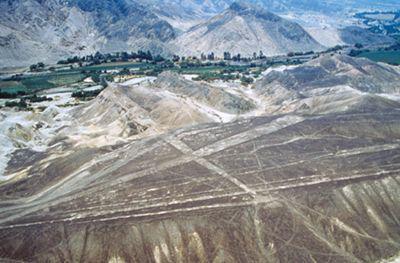The Ancient Alien Question (25 page)
Read The Ancient Alien Question Online
Authors: Philip Coppens

Ollantaytambo image courtesy of the author

The Wali Hopi Mesa is one of three Mesas in the heartland of the Hopi reservation in Arizona. Laid out according to Orion’s Belt (
background image of Orion Nebula
), it formed the final goal of a series of wanderings by various Native Americans, carried out on orders of their god, Maasaw.
Wali Hopi Mesa image courtesy the Hearst Museum. Background image. Credit: NASA,ESA, M. Robberto (Space Telescope Science Institute/ESA) and the Hubble Space Telescope Orion Treasury Project Team

The Tayos Cave was once wrongly identified as the site of the famous Metal Library, arguably one of the greatest treasure troves ever discovered. But when the Cave was explored in 1976, it became evident that sections of the complex were man-made.

The temple complex of Baalbek in Lebanon became the home of the largest Roman temple. But it is the platform below the Roman complex that is one of the great enigmas of the ancient world: it contains stones that weigh hundreds of tons, and no one knows how they were transported.
Tayos Cave image © Estate of Stan Hall, used with permission.
www.goldenlibrary.com
. Baalbek image courtesy of author

The Piri Reis map is an early 16th-century map that was constructed using several maps. The map shows the correct longitudes for the Brazilian coastline and, as some researchers suggest, the correct, pre-glacial coastline of Antarctica, a continent that would only be discovered three centuries later.

When the Spanish Conquistadors discovered the Coricancha, the Temple of the Sun, in the heart of the Inca capital of Cuzco, they stripped all the walls of their gold. Little remains of the temple, but what does remain reveals extraordinary workmanship that went into it, including this doorway.
Piri Reis map image from Wikipedia, made available through the Wikimedia Commons License. Coricancha door image courtesy of author

The Nazca lines in Peru are one of the mainstays of the Ancient Alien Theory. Their patterns are reminiscent of the landing strips of modern airports; indeed, many tourists visiting the lines approach them in an airplane in a faux aborted landing so they can experience the full excitement.

Nazca line images courtesy of Erich von Däniken, used with permission
In the 19th century, when Frenchman Augustus LePlongeon found seashells at Tiahuanaco he concluded that the city had been a seaport in antediluvian times and had likely been located at a far lower altitude. Then somehow, a cataclysm—the Deluge—had lifted up the entire mountain range. Arthur Posnansky was the next to claim that Tiahuanaco was antediluvian. He labeled it the oldest city on Earth. Posnansky calculated it to date back to 15000
BC
. Various university professors, such as Dr. Hans Ludendorff, director of the Astronomical Observatory of Potsdam, were intrigued by Posnansky’s interpretation and held a three-year study, between 1927 and 1930, and concluded that Posnansky was right. Today, scientists state that Posnansky has been proven incorrect.
LePlongean and Posnansky weren’t the first to give Tiahuanaco such an eminent distinction. When chronicler Pedro de Cieza de Leon asked the natives there whether the Inca had built Tiahuanaco, they “laughed at the question, affirming that they were made long before the Inca reign and...that they had heard from their forebears that everything to be seen there appeared suddenly in the course of a single night.” Another Spanish visitor added that his information said that the stones had been miraculously lifted off the ground, and “carried through the air to the sound of a trumpet.”
7
But the most enigmatic feature of the Tiahuanaco complex is Puma Punku, a structure that proponents of the Ancient Alien Theory almost uniformly hold as among the best available evidence for it. One of the construction blocks here weighs an estimated 440 tons, and others weigh between 100 and 150 tons. Many of these monoliths were fixed with I-shaped metal clamps. However, it is not the size of the blocks that is of primary interest but the precision of the stonecutting—to one 10th of a millimeter, roughly the thickness of a piece of paper. Each stone has three-dimensional edges; modern cutting machines do not allow us to make the sharp edges we see here. There are a series of complex blocks, the so-called H-letter-type blocks, which have almost 80 surfaces each—rather than the usual six surfaces on a normal brick. The precision of these blocks rules out manual processing: The sides are smooth, have exactly the same diameter, and are precisely parallel. One block contains a precise groove that has a semi-elliptical cross section, 4.5 millimeters wide and around 1 meter long. In it, distanced at 28 millimeters, is a row of holes, with a diameter slightly less than that of the groove. All the holes have the same diameter of 4 millimeters, and the deviations in depth between the holes do not exceed 0.1 millimeters—stunningly precise. Only extremely sophisticated machining can accomplish such a block today. What made these stones in Puma Punku? Science has no answer, and wishes Puma Punku to remain largely unknown—in stark contrast with the fame Tiahuanaco had among the Inca.

Puma Punku is one of the world’s most enigmatic sites. The stones are not only gigantic in size, but they also show chiseling that is so precise and intricate that it is beyond the means of ordinary tools, but required machinery on par with our most modern equiptment.

